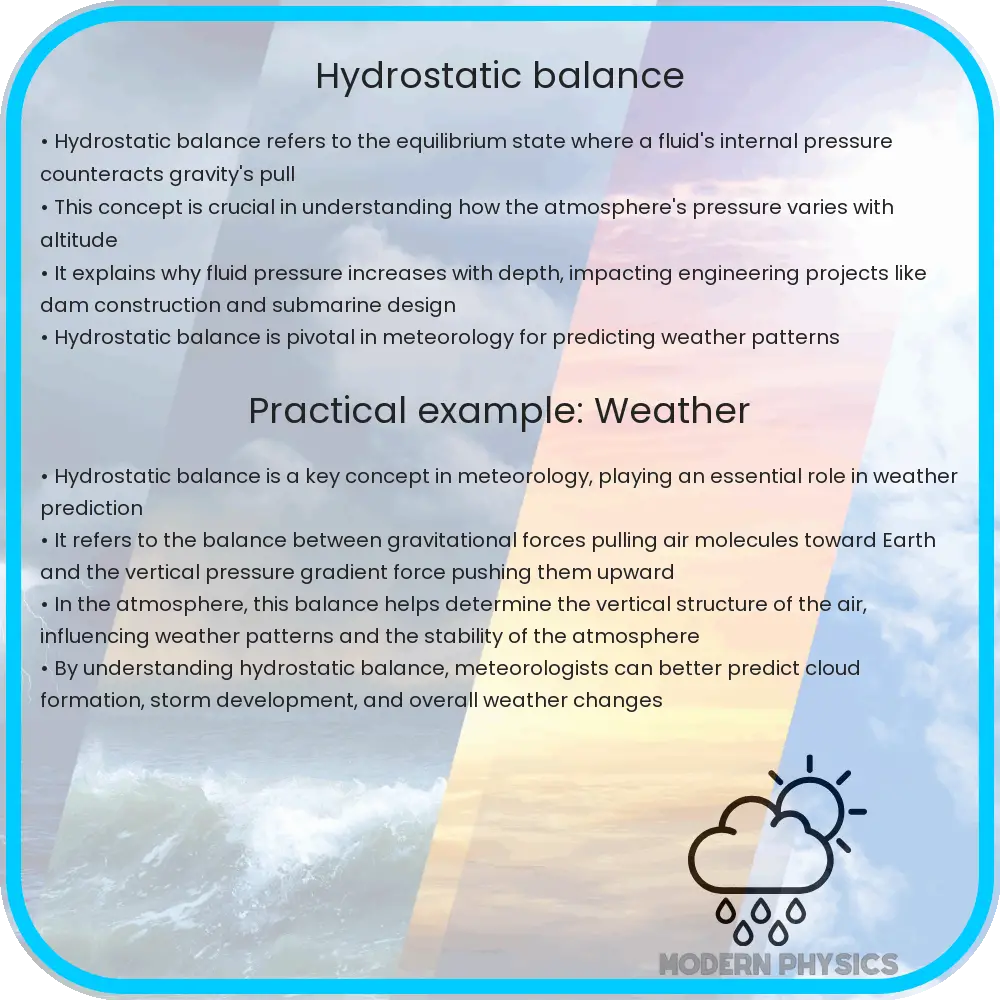Explore the principles of hydrostatic balance in fluid mechanics, its equations, and diverse applications in meteorology, oceanography, and engineering.

Understanding Hydrostatic Balance: Fundamental Concepts
Hydrostatic balance is a key concept in fluid mechanics, particularly relevant in meteorology and oceanography. It describes a state where the gravitational force acting on a fluid is exactly balanced by the pressure gradient force. This equilibrium is crucial for understanding weather patterns, ocean currents, and the behavior of fluids in various contexts.
Principles of Hydrostatic Balance
At the core of hydrostatic balance is the interplay between gravity and pressure. Gravity pulls fluid particles downwards, while pressure, increasing with depth, acts in the opposite direction. When these forces are equal, the fluid is said to be in hydrostatic equilibrium. This balance can be observed in oceans where the deeper you go, the greater the pressure due to the weight of the water above.
The Hydrostatic Equation
The hydrostatic equation mathematically expresses this balance. In its simplest form, it is written as:
\( \frac{dP}{dz} = -\rho g \)
where:
- P represents the pressure,
- z is the height,
- \(\rho\) is the density of the fluid, and
- g is the acceleration due to gravity.
This equation shows that the rate of change of pressure with respect to height is proportional to the negative product of fluid density and gravitational acceleration. It’s a cornerstone in meteorology for understanding atmospheric pressure changes.
Applications of Hydrostatic Balance
Hydrostatic balance has numerous applications:
- Meteorology: In weather forecasting, understanding hydrostatic balance helps in predicting atmospheric pressure changes, which are critical for weather patterns.
- Oceanography: It explains the distribution of pressure in oceans, aiding in the study of ocean currents and marine life habitats.
- Engineering: Engineers use hydrostatic principles in designing dams, submarines, and hydraulic systems.
The concept also finds applications in various scientific and industrial fields, demonstrating its widespread relevance.
Understanding hydrostatic balance is not only about comprehending the equilibrium in fluids but also about appreciating the delicate balance nature maintains in our environment. This concept offers insights into the workings of the natural world, from the depths of the oceans to the heights of the atmosphere.
Deepening the Understanding of Hydrostatic Balance
Delving further into hydrostatic balance, it’s important to understand its limitations and the conditions under which it applies. Hydrostatic balance is an idealization and applies best to fluids at rest or in steady, slow-moving conditions. In fast-moving fluids or where there are strong external forces, such as in turbulent weather systems, the balance may not hold true.
Non-Hydrostatic Effects in Fluid Dynamics
In scenarios where hydrostatic balance does not apply, non-hydrostatic models come into play. These models consider additional forces and dynamics, providing a more comprehensive understanding of fluid behavior in complex situations like storm systems, rapid ocean currents, and industrial applications involving high-speed fluid flow.
Implications in Climate Studies
The concept of hydrostatic balance is also instrumental in climate studies. By understanding how this balance is maintained in the Earth’s atmosphere and oceans, scientists can better predict and model climate patterns and changes. This includes studying phenomena like El Niño, monsoons, and the effects of global warming on ocean currents.
Technological Applications
Advancements in technology have allowed for more accurate measurements and models of hydrostatic balance. This has led to improved weather forecasting, better design of marine and aerospace vehicles, and more efficient fluid transport systems in industries.
Conclusion
Hydrostatic balance, a fundamental principle in fluid dynamics, plays a critical role in a wide range of scientific and practical applications. From its basic principles to its complex applications in meteorology, oceanography, engineering, and climate science, understanding hydrostatic balance is essential for grasping the behavior of fluids in our natural and engineered environments. While it’s an idealization, its relevance and applicability in various fields underscore the delicate and dynamic balance of forces in our world. The continuous study and exploration of hydrostatic balance and its related phenomena remain crucial for advancing our knowledge and technological capabilities in managing and utilizing the power of fluids in our planet’s system.
